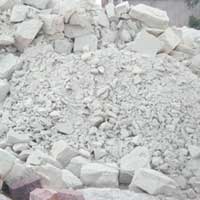Difference between revisions of "China Clay"
| Line 1: | Line 1: | ||
{{Infobox_Minerals | {{Infobox_Minerals | ||
| image = China_Clay.jpg | | image = China_Clay.jpg | ||
| − | | origin = | + | | origin = USA, Europe, Russia, China |
| − | | stowage factor = | + | | stowage factor = <ul><li>1,46/1,70 m<sup>3</sup>/t (bags)</li><li>1,13 m<sup>3</sup>/t (bulk) |
| humidity and moisture = - | | humidity and moisture = - | ||
| ventilation = - | | ventilation = - | ||
| Line 8: | Line 8: | ||
}} | }} | ||
==Description== | ==Description== | ||
| − | A white or | + | A white or greyish powder, crystals or pellets; activated by sulphuric acid. May absorb water up to many times its own volume. <br><br> |
| − | + | This commodity is well known as [[Kaolin]]. Other names are: [[Porcelain clay]], [[Cornish clay]], [[Argilla]], [[White bole]], [[Pipe clay]], [[Porcelain earth]] and Catalpo. The purest form of clay (a silicate of [[aluminium]]) used in the manufacture of china, distemper work and other purposes.<br><br> | |
| − | + | [[Kaolinite]] is a mineral belonging to the group of Aluminosilicates. It is commonly referred to as "China Clay" because it was first discovered at Kao-Lin, in China. The term [[Kaolin]] is used to describe a group of relatively common clay minerals dominated by kaolinite and derived primarily from the alteration of alkali feldspar and micas.<br><br> | |
| − | + | Kaolin is a white, soft, plastic clay mainly composed of fine-grained plate-like particles. Kaolin is formed when the anhydrous aluminium silicates which are found in feldsparrich rocks, like granite, are | |
| − | + | altered by weathering or hydrothermal processes. The process which converted the hard granite into the soft matrix found in Kaolin pits is known as "kaolinisation". The product has a high fusion point and is the most refractory of all [[clays]]. <br><br> | |
| − | <br><br> | + | Used as a filler and coating for paper, and in the manufacture of refractories, ceramics, cements, fertilizers, [[chemicals]] (especially [[aluminium]] sulphate), catalyst carrier, anticaking preparations, cosmetics, insecticides, paint, source of [[alumina]], adsorbent for clarification of liquids, electrical insulators. <br><br> |
| − | + | ||
| + | See also [[Aluminium Silicate]]. | ||
| + | |||
[[Category:Minerals and rocks]] | [[Category:Minerals and rocks]] | ||
[[Category:Products]] | [[Category:Products]] | ||
Revision as of 11:51, 8 April 2013
| Infobox on China Clay | |
|---|---|
| Example of China Clay |  |
| Facts | |
| Origin | USA, Europe, Russia, China |
| Stowage factor (in m3/t) |
|
| Humidity / moisture | - |
| Ventilation | - |
| Risk factors | - |
China Clay
Contents
Description
A white or greyish powder, crystals or pellets; activated by sulphuric acid. May absorb water up to many times its own volume.
This commodity is well known as Kaolin. Other names are: Porcelain clay, Cornish clay, Argilla, White bole, Pipe clay, Porcelain earth and Catalpo. The purest form of clay (a silicate of aluminium) used in the manufacture of china, distemper work and other purposes.
Kaolinite is a mineral belonging to the group of Aluminosilicates. It is commonly referred to as "China Clay" because it was first discovered at Kao-Lin, in China. The term Kaolin is used to describe a group of relatively common clay minerals dominated by kaolinite and derived primarily from the alteration of alkali feldspar and micas.
Kaolin is a white, soft, plastic clay mainly composed of fine-grained plate-like particles. Kaolin is formed when the anhydrous aluminium silicates which are found in feldsparrich rocks, like granite, are
altered by weathering or hydrothermal processes. The process which converted the hard granite into the soft matrix found in Kaolin pits is known as "kaolinisation". The product has a high fusion point and is the most refractory of all clays.
Used as a filler and coating for paper, and in the manufacture of refractories, ceramics, cements, fertilizers, chemicals (especially aluminium sulphate), catalyst carrier, anticaking preparations, cosmetics, insecticides, paint, source of alumina, adsorbent for clarification of liquids, electrical insulators.
See also Aluminium Silicate.











